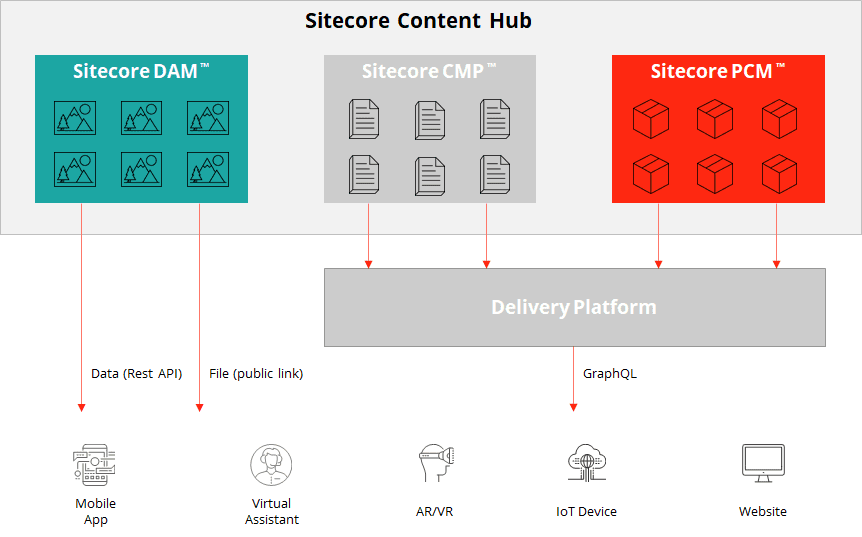Recently we released the Sitecore Experience Edge for Content Hub and we plan to release Sitecore Experience Edge for Experience Manager (XM) sometime during the second quarter of 2021. For now, we will focus on what is available right now.
The Sitecore Experience Edge brings content
management features into the Sitecore Content Hub. In addition to the content management features, it adds a global auto-scaled delivery platform that hosts a
high performing GraphQL API.
This complete service is hosted and managed by Sitecore allowing content delivery at scale to any digital touchpoint.
Let’s break it down and go over all the components piece by piece:
Sitecore Content Hub
When using the Sitecore Experience Edge, Content Hub becomes a content management system. For that we are utilizing the Content Marketing Platform (CMP) feature that was already available within Content Hub. By adding the Experience Edge, we added a delivery method that is designed to be flexible and high performant.
However, with the Sitecore Experience Edge we are not limited to delivering only content. You can also deliver Sitecore Product Content Management (PCM) data
using the Experience Edge or any custom definitions you have defined within Content Hub.
Apart from content, the Experience Edge also supports the use of Digital Asset Management (DAM) assets by providing the links to the assets hosted on the CDN.

API
To consume the content delivered by the Sitecore Experience Edge you will need to make requests to the API. There are three API endpoints available, each with a different purpose.
First, we have the Preview API. You can use the Preview API to access all content, including drafts and other content that is not approved yet. Please note that
the Preview API is not optimized for public consumption in a production environment. You can access the Preview API by using the url:
https://[YouContentHubUrl]/api/graphql
Then there is the Delivery API. The Delivery API provides access only to approved and published content. You will use this API for all production-related
actions. The Delivery API is a GraphQL API exposing the Delivery platform with identical schema to the Preview API. It is optimized for performance and
geo-replicated latency. The base URL for the Delivery API is https://delivery.sitecore-staging.cloud/instanceId/graphql where instanceId is your unique
identifier provided during provisioning.
In order to work with the delivery API you will need to authenticate using API keys. One way of creating a key would be to go to the settings within your Content Hub instance. Another option is to request such a token by using the Token API.
The Token API serves as a management tool to validate API keys used for accessing the Preview and Delivery GraphQL APIs. The URL for all token API requests is the URL for the delivery platform with “/token/api/apikey” appended.
Delivery Platform

The delivery platform is a global and auto-scaled delivery platform. It improves the content publishing experience of Sitecore Experience Edge for Content Hub. The Content Delivery Network (CDN) acts as a proxy layer between your application(s) and the delivery platform.
GraphQL serves as the querying language to consume data from Sitecore Content Hub and deliver it to your custom channels. The CDN links the delivery platform to static or dynamic sites, and any other runtime applications that can consume GraphQL data. All queries going to and coming from the delivery platform will get cached by the CDN to optimize response times.
Whenever Content Hub detects changes in approved content, or changes to the schema it raises an event which triggers the automatic publishing process.
The delivery platform is a multi-environment platform: it provides delivery services for multiple Content Hub environments and is distributed at a regional level. That is, a delivery platform instance is available in all major cities or regions around the world. This geographical distribution offers a scalable solution with minimal response times. Additionally, the content of all environments will be duplicated in all delivery platform instances to improve resiliency and availability.
As you can see, the combination of all these components really complement Content Hub and make it possible to deliver content to any channel on a global scale.